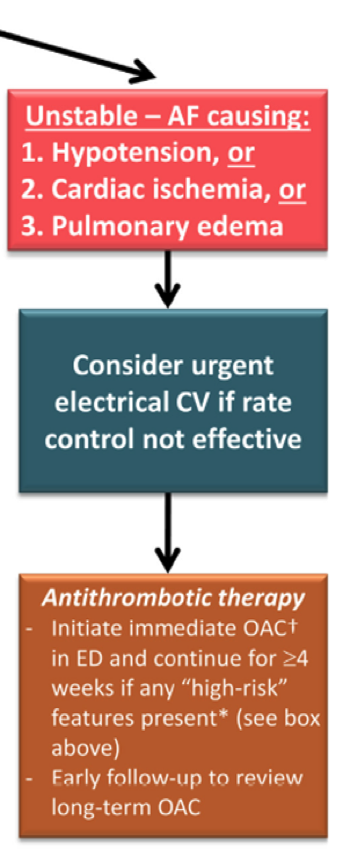We continue to discuss the latest recommendations for ED management of atrial fibrillation (AF) as presented in the newly published 2014 Focused Update of the Canadian Cardiovascular Society Guidelines for the Management of Atrial Fibrillation. The Guidelines PDF can be downloaded from the CCS website at 2014 Canadian Cardiovascular Society Guidelines for the Management of Atrial Fibrillation
Beware of Unstable Patients who are in Permanent AF!
For patients whose recent-onset AF/AFL is the direct cause of instability with hypotension, acute coronary syndrome, or florid pulmonary edema, CCS recommends that immediate electrical cardioversion be considered if rate control is not effective or safe. Unless AF-onset was clearly within 48 hours orthe patient has received therapeutic OAC for >3 weeks, CCS recommendsimmediate initiation of intravenous or low molecular weight heparin prior to cardioversion (if feasible) followed by therapeutic OAC for 4 weeks afterwards. Novel OACs have the advantage of almost immediate onset of action. (Strong recommendation, Low Quality Evidence)
Practical Tip #13: Caution is required in patients with permanent AF who present with instability as they may not benefit from cardioversion and may be made worse by attempts to do so.
Practical Tip #14: In patients with long standing AF and hemodynamic instability and a ventricular rate less than 150 beats per minute, the instability is likely due to causes other than AF (e.g. hypoxia, pain, sepsis) and is unlikely to respond to cardioversion.
Practical Tip #15: Immediate and adequate rate control may alleviate the clinical instability and obviate the need for immediate cardioversion.
Unstable AF Treatment Algorithm (Figure)
Ian Stiell MD
Twitter: @EMO_Daddy

